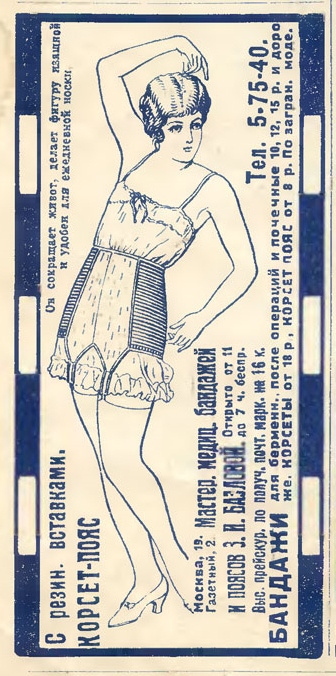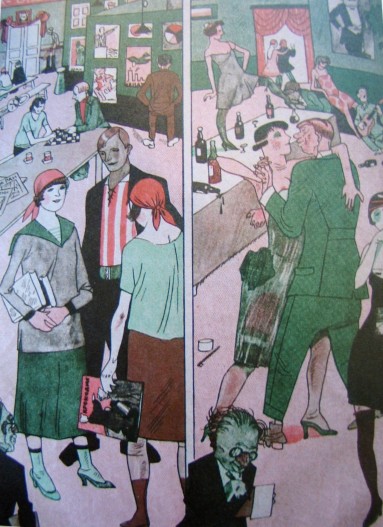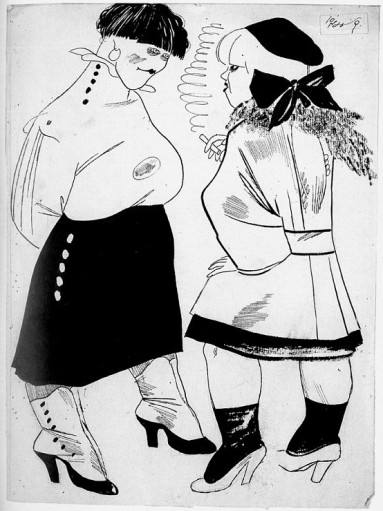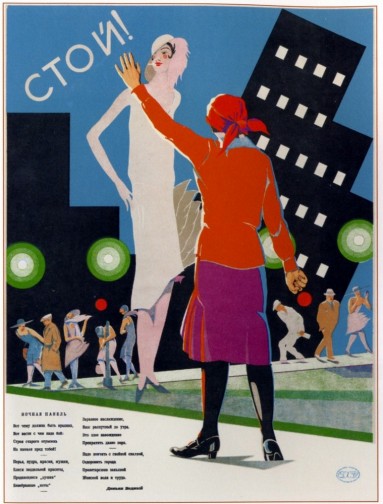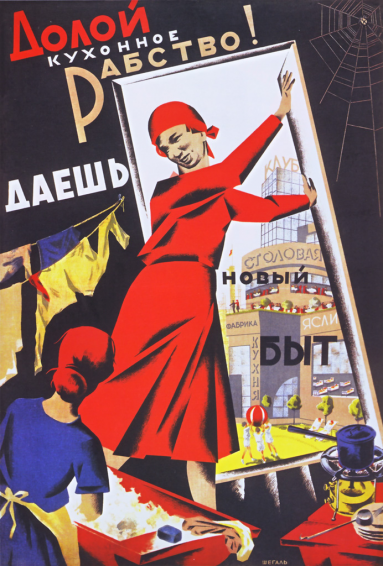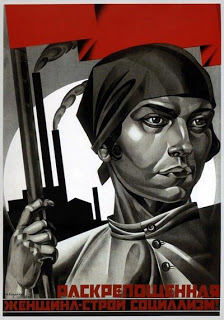Libidinal economizing in the early Soviet Union
"She had suffered an acute attack of ‘love’- the name given to a disease of ancient times when sexual energy, which should be rationally distributed over one’s entire lifetime, is suddenly concentrated into one inflammation lasting a week, leading to absurd and incredible behavior." —Vladimir Mayakovsky, The Bedbug
In summer 1956, six tons of books were thrown by court order into the public incinerator on 25th Street in New York City. Those smouldering pages were written by Wilhelm Reich, who died in jail shortly thereafter, infamously denounced as the fraudulent peddler of “orgone,” a mystical cosmic life force. As a young communist psychoanalyst in interwar Vienna, Reich had argued that capitalism unhealthily restrains primal sexual instincts, and that a genuine political revolution would shatter the constraints of bourgeois sexual morality, unleashing sexual energies through a kind of wild orgasmic release.
In 1929, Reich visited the Soviet Union, where psychoanalysis would soon be outlawed, and was rather scathing of the psychologists he met there, including one of his hosts, Aron Zalkind, a leading figure in the psychological community in Moscow. Zalkind was the author of the influential treatise “12 Commandments for the Sexual Revolution of the Proletariat,” first published in 1925, which argued that the capitalist free market was incompatible with what he somewhat confusingly called “free love,” given that he meant something like the opposite of what it meant in the 1960s. Unlike Reich, whose prurient embrace of unrestrained lovemaking was to be enthusiastically championed during the “sexual revolution” of the 1960s, Zalkind advocated sexual abstinence as the appropriate conduct for the revolutionary proletariat.
During the period of the New Economic Policy (1921–1928), which saw the reintroduction of certain forms of private enterprise into the Soviet economy, sexual relations were being renegotiated for both ideological and practical reasons. As the heroine of Feodor Gladkov's 1925 novel Cement observes: “Everything is broken up and changed and become confused. Somehow love will have to be arranged differently.” But how exactly love was to be arranged was unclear. Although the fledgling Soviet government had legalized divorce and abortion, secularized marriage, and decriminalized homosexuality, and although women's roles in the home and workforce were being concretely transformed, Zalkind's emphasis on sexual inhibition is characteristic of the ambivalence toward sex during the NEP period.
Zalkind’s commandments were as follows:
- Sexuality should not develop too early.
- Sex should not occur before marriage.
- Sex on the basis of pure physical attraction should be renounced.
- Sex should only result from “deep and complex feeling” between comrades.
- Sex should be infrequent.
- Sexual partners should not be changed too frequently.
- Sexual relationships should be monogamous.
- Every sex act should be committed with the awareness that it might lead to the birth of a child.
- Sexual partners should be selected on the basis of class. (“Sexual attraction to class antagonism, to a morally disgusting, dishonest object, is as perverse as the sexual desire of a human for a crocodile or an orangutan.”)
- There should be no jealousy.
- There should be no “sexual perversions.”
- In the interests of the revolution, it is the duty of the proletariat to intervene in the sex lives of others.
Zalkind relies on an economic, quantitative conception of psychic sexual energy or libido borrowed from Freud. In the interest of self-preservation, the fragile organism must protect itself from both external and internal excitations, and the constant tension between pleasure and unpleasure must be regulated through sublimation, repression, and cathexis. Or in Zalkind's inelegant phrasing, “The body is stuffed with a certain amount of energy, a certain amount of internal stress and excitement, which erupts on the outside.”
In The Future of an Illusion — the last of Freud's works to appear in Russian translation in 1930, with a hostile introduction by Zalkind — Freud is dismissive of those who would claim that “a reordering of human relations” might overcome the necessarily repressive character of society, stating that “every civilization must be built up on coercion and renunciation of instinct,” (though he explicitly declares that his conclusions are not intended as a comment on the “great experiment in civilization” occurring in Russia). Unlike Reich, Zalkind does not contradict Freud on this point. He may imagine repression and sublimation as conscious, voluntary, and collective, but he insists that communism cannot be built without forgoing immediate gratification. The oft-repeated Soviet injunction to make sacrifices in the present to reap the eventual benefits of the bright Communist future corresponds to Freud's reality principle, defined in Beyond the Pleasure Principle as the “temporary toleration of unpleasure as a step on the long indirect road to pleasure.”
Freud argued that giving the instincts free rein would be dangerous. Civilization is a by-product of repressed instincts rather than the result of some immanent tendency toward progress or perfectibility. By assuming that renouncing pleasure will ultimately lead to a superior form of society, Zalkind's argument is more explicitly value-laden: Sex too much, too soon, too often or with too many people diverts energy that could otherwise be used for building the new Communist society. For Zalkind, sexual desire does not originate in the seething depths of the primitive unconscious. Sex is morally rather than mortally dangerous; it is wasteful and frivolous rather than primal and destructive.
In Freud's theory, the regulation of psychic energy remains largely metaphorical. But Zalkind insists that Freudian theory has a materialist essence; his more literal conception of energy thus has a closer relation to contemporary discussions of labor efficiency and industrial production. In tune with this infamously Taylor-obsessed period, Zalkind focuses on management, rationality, organization, and discipline.
But if under capitalism, energy expenditure is primarily concerned with maximized productivity and profitability in the workplace, in communism all human activity is up for grabs, including people's most intimate encounters. Any unnecessary exertion might deviate resources that could otherwise be spent building the new classless society. Zalkind's quantification of energy allows for the commensurability of action. As historian Anson Rabinbach puts it in The Human Motor: Energy, Fatigue, and the Origins of Modernity, “Energy is the universal equivalent of the natural world, as money is the universal equivalent of the world of exchange.”
Building barricades, constructing dams, designing factories, or fucking your comrades — all activity is reduced to the amount of energy they require to perform. Zalkind imagines a scenario in which a worker is insulted by his boss. Such an event, he claims, produces a fixed volume of anger, which will inevitably “break out”: The worker might erupt and throw a plate at his wife. But instead, the energy could be positively channelled into organizing a demonstration or distributing agitational pamphlets.
Zalkind's vision recalls Yevgeny Zamyatin's 1921 dystopian novel We, in which controlled copulation can be performed only during the alloted “sex hour,” when people are permitted to lower the curtains in their glass homes, and encounters must be tracked with a pink ration book of signed tokens. But these concerns were not confined to the pages of science fiction: Some married couples in the period actually attempted to organize their domestic chores and sex lives on the basis of the Scientific Organization of Labor.
Despite his likening of the libido to a flowing liquid, Freud's conception of the unconscious knows no spatial constraints – quantity has no meaningful existence there. In bourgeois Vienna, there is no suggestion that a patient's libidinal resources might simply run out; their sexual drives are understood in relation to their historical experiences rather than their physical well-being.
But in post-revolutionary Russia there was a genuine fear that people were literally running out of energy. Zalkind's anxieties about squandering libidinal currency rely on a physiological understanding of energy developed amid acute privation. “Exhaustion” was rife among revolutionaries; Lenin's death in 1924 from a brain hemorrhage was said to have been provoked by his excessive exertions on behalf of the global revolutionary proletariat. Hunger, often accompanied by energy-sapping cold, gnaws insistently in first-hand accounts of the period. Revolution and Youth, the book in which Zalkind's proclamations were originally published, includes detailed nutritional charts to ensure revolutionaries retain optimal “brain fuel.” Victor Serge's Memoirs of a Revolutionary constantly returns to the subject of food (or lack of it), its pages strewn with paltry, unappetizing morsels. Stoic revolutionaries survive on black bread, dried fish, coffee made from raw oats, rotten horsemeat, and the odd spoonful of sugar. This nutritional dearth had sexual implications: As a result of malnutrition, impotence was widespread.
The acute privations of war communism may have abated with the NEP reforms, but ideological uneasiness also accompanied the re-emergence of private enterprise. Luxury was condemned, hardship romanticized. Serge's memoirs begin with the following assertion of revolutionary commitment: “Thou shalt think, thou shalt struggle, thou shalt be hungry.” Emma Goldman described the confusion wrought by the sudden reappearance of food on the streets of Moscow in the wake of the NEP:
Large quantities of butter, cheese, and meat were displayed for sale; pastry, rare fruit, and sweets of every variety were to be purchased. . . . Men, women, and children with pinched faces and hungry eyes stood about gazing into the windows and discussing the great miracle: what was but yesterday considered a heinous offense was now flaunted before them in an open and legal manner.
Zalkind's treatise captures something of this confusion. The renunciation of sex was connected to the renunciation of food; both were related to ideological purity and self-sacrifice. He explicitly equates sexual excess with gluttony and is obsessed with the chaos of bourgeois sexuality and its “rampant leakage of energy wealth.” Similarly, Alexandra Kollontai's “thin and under-nourished,” idealized communist heroine Vasilisa Malygina drinks “nothing but water, eat[s] slops, dress[es] in rags” and infuriates her NEP-man lover by falling asleep during sex as she's so tired from organizing a worker's commune. Meanwhile, NEP-men and women were typically represented as disgustingly obese, often gorging themselves on rich food. Bourgeois decadence is physically manifested in luxuriant folds of flesh.
Fat signifies licentiousness, particularly when attached to female bodies: Pendulous breasts and ample thighs become emblems of wantonness. These fleshy appendages were often perilously combined with commodities associated with (bourgeois) femininity as masquerade. Fripperies such as synthetic stockings, bright lipstick, perfume with French-sounding names, and gaudy jewelry were condemned as a frivolous expense — like sex itself — and for unnecessarily arousing male sexual desires.
Eric Naiman discusses this symbolism of fat at length in Sex in Public: The Incarnation of Early Soviet Idology, but frames it in terms of anorexia, projecting a contemporary American discourse into the past. The anorexic wants to remain stuck in childhood, whereas Soviet renunciation has a very different purpose. In their immediate pursuit of gratification and rejection of sublimation, the fat, reprobate NEP-people behave like children. In contrast, the committed communist will always forswear pleasure in the present, not because they want to stop their progressing but precisely for the sake of the bright future to come.
***
In the 1990s, when scarcity and barter returned to the Soviet Union on a scale not seen since the 1920s, a tire factory in Volgograd allegedly paid its employees in dildos. This stark image of fungible, mechanized pleasure seems to conform to Zalkind's own treatment of sexual behavior. What, if anything, distinguishes his understanding of economy from a capitalist one?
“The Adventures of the Rouble” — written by Soviet national-anthem author Sergei Mikhalkov in 1967 — tells the story of a day in the life of a rouble. The rouble is first given to an industrious carpenter who uses him to buy carnations for his wife on International Women's Day, but he ends up being given as change by a cabdriver to an American, in whose wallet he meets some arrogant U.S. dollars. They tell the incredulous rouble of their previous adventures — they had been given to a pilot as payment for successfully bombing foreign cities, then squandered on drinks in a bar, before being found in the hands of a wrongfully accused black man killed in a police dragnet. Our comrade the rouble, who takes such pride in his role helping people to acquire simple quotidian items, is horrified. He thinks he has nothing in common with these brash, green monsters. But even taking into consideration the peculiarities of the Soviet economy, there is nothing in the rouble's form that prevents him from being used for activities just as horrifying as those described by the American dollar.
Zalkind, in regarding energy as currency, makes a similar assumption as Mikhalkov’s rouble makes. But conceiving of revolutionaries as having an abstracted aggregate of energy risks draining both revolutionary activity and sex (assuming the two are mutually exclusive) of any definable qualities. Difference dissolves into general equivalence. Jacques Derrida's remarks in The Postcard about Freud's economic conception of the relation between pleasure and unpleasure are apposite here. Freud, he says, implicitly supposes that we know what pleasure is but fails to actually tell us anything about it:
Nothing is said of the qualitative experience of pleasure itself. What is it? What does it consist of? … The definition of the pleasure principle is mute about pleasure, about its essence and quality. Guided by the economic point of view, this definition concerns only quantitative relations
However, the renunciation demanded by the reality principle does assume that pleasure (however ill-defined) will eventually be reached. Mikhalkov's rouble changed hands during the stagnant Brezhnev era, when the fervent pursuit of utopia had been indefinitely deferred. Zalkind's rejection of immediate satisfaction through sex and the forms of consumption (both calorific and monetary) assumed to accompany it is premised on a faith in a greater and deeper love to come: communism.
The Soviet fixation with machines and industrialization was distinctly utopian. A Taylorist understanding of energy allowed for the productive forces of human labor to be equated with the productive forces of machines. In communism, it was hoped, the latter could take on the work of the former to reduce human labor time, releasing people from exploitation into a new world in which energy could eventually be distributed freely.
The contradiction between the coruscating future and the shabby present animates NEP-era discourse. A key preoccupation was the transformation of byt, or everyday life. Constructivist artists famously turned their attentions away from pieces for sequestered galleries to quotidian objects — clothing, buildings, kitchen utensils, food packaging. The clutter of the domestic sphere was associated with the vestiges of the old world that needed to be blasted away to make room for the new.
The private home, with its tawdry little objects was, of course, associated with women and the drudgery of housework. Here too it was thought that energy ordinarily expended by humans might be taken over by machines. The novel Vasilisa Malygina ends with the eponymous heroine discovering that she is pregnant. A gynecologist asks if she will return to her husband to avoid raising the child alone, but Vasilisa replies:
“I’m not alone, though. Tomorrow I’m leaving for the weaving works. There’s a fine group there, mostly women, weavers. We’ll all work together there, organize a nursery...” A baby! That would be nice. She would show the other women how to raise a child in the Communist way. There was no need for a kitchen, for family life and all that nonsense.
Sergei Tretiakov's banned 1926 play I Want a Baby! stages the contradictions in NEP-era attitudes to sex. Although the play's protagonist Milda is too absorbed in revolutionary activity to be distracted by romance, she is suddenly overcome by the overwhelming desire to have a baby. She does not, however, want to have a husband or a family. Inspired by a eugenicist comrade, she decides to find the finest specimen of proletarian to mate with, explicitly relating the organization of production to the organization of reproduction. Milda, like Vasilisa, plans to raise her child collectively. She looks hopefully to the future, foreseeing the complete transformation of domestic life:
Give it a few years. They'll finish building the block. The days of primus stoves and poky little rooms will be long gone...The concept of the housewife will be outmoded. People will have relaxed. There'll be a nursery.
Both Milda and Vasilisa not only abjure but seemingly abhor sex and the bodies that perform it; their masculine appearance (flat chests, masculine clothing, and short hair) is in stark contrast to the voluptuous giggling romantics they are surrounded by, their abdication of sexuality signifying an unwavering commitment to the revolution. Sex here is not presented as merely a distraction from revolutionary work, but is connected to patriarchal oppression. Cement's heroine Dasha, transformed by the revolution into a red-kerchiefed androgyne, refuses her husbands advances, exclaiming, “I'm not even a human being to you, am I, Gleb? Can't you see I'm your comrade?... Half-witted obedience, nice little girl, that's not me.”
But though sex itself is portrayed as both frivolous and oppressive (at least for the time being), women are paradoxically presented as being emancipated through bearing children. Pregnancy emerges as the ultimate contribution to the revolution. In No Future: Queer Theory and the Death Drive, Lee Edelman provocatively argues that the image of the child functions to uphold an unquestioned and unquestionable faith in the future upon which all political visions depend. But Edelman assumes that reproduction necessarily reproduces the hegemonic social order, or more precisely, that it reproduces some form of social order. He rejects all projects that might attempt to organize society less oppressively as inherently conservative insofar as they affirm a structure —any structure. Queerness as death drive is pure negation.
Conspicuously absent from No Future is any discussion of the relationship between the ideology of reproductive futurism and the oppression of women. And this, surely, is one of the most compelling reasons to resist the injunction to reproduce. Reproduction is understood in the narrowest possible sense – Edelman's concern is with ideal rather than concrete babies, who appear on his pages as if by immaculate conception – without any consideration of how or by whom children are borne and raised. That is, his understanding of reproduction does not include any discussion of social reproduction and its place in the maintenance of the existing social order.
But early Soviet representations of motherhood present children as a breaking with rather than sustaining the “telos of the social order” that Edelman attacks. Reproduction becomes a form of non-reproduction. And this has implications not only for the future (that is, for the child), it also affords the woman the opportunity to escape patriarchal domination and throw herself into the collective, enabled by the state provision of communal childcare facilities, reconfigured workplaces, and transformed housing.
Yet, as Stalin consolidated his power in the 1930s, traditional family structures were celebrated once more. The image of the ruddy-cheeked, ample-bosomed woman of the fields that accompanied this political shift was always associated with fecundity, nature, and plenty. The child once again became a means of perpetuating the existing, if constantly progressing, social order — new life built on an ever increasing mound of corpses.
The pain and discomfort of pregnancy is conveniently glossed over in NEP-era celebrations of the child, gesturing toward a future where women could be emancipated from biological compulsion, where gender as such would cease to exist. Pregnancy is depicted as something more cerebral than corporeal: It occupies the mind rather than the womb, functioning as a kind of transcendent connection to the future, detached from the messy corporeality of the present. Maternal love is transferred from the individual to the collective, becoming the prototype for all communist love: equally distributed, unconditional, and committed, beyond the constrictions of the couple form or the family.
These visions of androgynous communist heroines and rows of indistinguishable babies in children's homes cast the dissolving of distinction in a positive light. Serge declared that revolutionary struggle was a sacrifice for the sake of the future, seeing his actions as integrated into the movement of history. As such, he renounced his identity, changing his name or posting at the bidding of the Party. He and his comrades were thus, he insists, interchangeable. In the context of the revolution, folding the specific into the general is framed as a necessary and, crucially, temporary aspect of the torturous journey to communism. But what happens when (or if) you eventually reach your final destination?
In 1970's The Dialectic of Sex, Shulamith Firestone argued that the Russian revolution failed because it failed to abolish the family. She acknowledges the familiar dystopian visions associated with radical attempts to transform social relations:
cold collectives, with individualism abolished, sex reduced to a mechanical act, children become robots, Big Brother intruding into every aspect of private life, rows of babies fed by impersonal machines, eugenics manipulated by the state ... all emotion considered weakness, love destroyed, and so on.
But, in the right hands, she insists that technology could participate in a revolution that would eliminate class antagonism along with gender difference.
Freed from the constraints of labor — meaning both work and childbirth — “sexuality would be released from its straightjacket to eroticize our whole culture, changing its very definition.” Intimacy, comfort, arousal, support, tenderness, affection, stimulation, laughter, intensity, and companionship might be diffused throughout life, not cloistered away in private fleeting moments between individuals.
